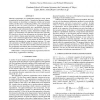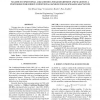ICASSP
2008
IEEE
14 years 5 months ago
2008
IEEE
Phoneme segmentation is a fundamental problem in many speech recognition and synthesis studies. Unsupervised phoneme segmentation assumes no knowledge on linguistic contents and a...
ICASSP
2008
IEEE
14 years 5 months ago
2008
IEEE
Understanding multi-party meetings involves tasks such as dialog act segmentation and tagging, action item extraction, and summarization. In this paper we introduce a new task for...
ICASSP
2008
IEEE
14 years 5 months ago
2008
IEEE
In this paper, we describe a novel statistical approach to the vocal tract transfer function (VTTF) estimation of a speech signal based on a factor analyzed trajectory hidden Mark...
ICASSP
2008
IEEE
14 years 5 months ago
2008
IEEE
This paper presents a modulation-based reconstruction method for audio signals across long gaps of missing samples. We use LTI filterbanks followed by a multiplicative model that...
ICASSP
2008
IEEE
14 years 5 months ago
2008
IEEE
We present a technique for denoising speech using nonnegative matrix factorization (NMF) in combination with statistical speech and noise models. We compare our new technique to s...
ICASSP
2008
IEEE
14 years 5 months ago
2008
IEEE
Robust Spoken Language Understanding (SLU) is a key component of spoken dialogue systems. Recent statistical approaches to this problem require additional resources (e.g. gazettee...
ICASSP
2008
IEEE
14 years 5 months ago
2008
IEEE
Prosody is an important cue for identifying dialog acts. In this paper, we show that modeling the sequence of acousticprosodic values as n-gram features with a maximum entropy mod...
ICASSP
2008
IEEE
14 years 5 months ago
2008
IEEE
With the development of voice transformation and speech synthesis technologies, speaker identification systems are likely to face attacks from imposters who use voice transformed ...
ICASSP
2008
IEEE
14 years 5 months ago
2008
IEEE
This paper shows how to improve Hidden Conditional Random Fields (HCRFs) for phone classification by applying various speaker adaptation techniques. These include Maximum A Poste...
ICASSP
2008
IEEE
14 years 5 months ago
2008
IEEE
In this research, an iterative and unsupervised Turbo-style algorithm is presented and implemented for the task of automatic lexical acquisition. The algorithm makes use of spoken...


